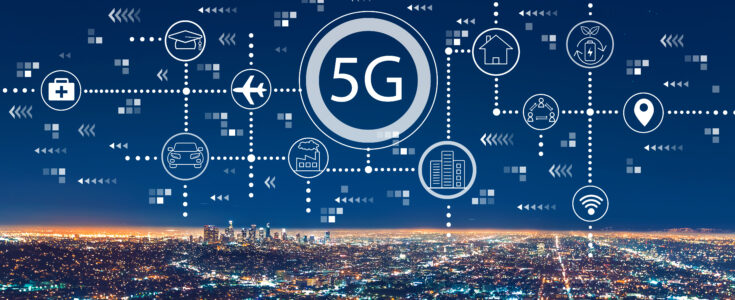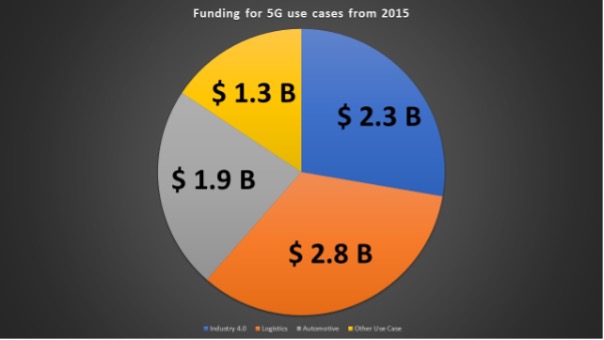
Why the Internet of Things Needs 5G Connectivity

As the connected society continues to both evolve and impact our daily lives, the number of devices that are part of the Internet of Things is accelerating at an astonishing rate. Depending on what resource you choose to seek out, there could be as many as 3.2 billion devices in play by the end of 2023, a significant increase on the 700 million that are part of the IoT today.
Although there are numerous reasons as to why connected devices are on the rise, there is very little doubt that the long-awaited integration of 5G communication technology will have an impact on this increase. And as 5G not only replaces the existing 4G standard but also becomes the norm, there is a defined need for companies and manufacturers to take this next generation of connectivity into account when designing, testing and launching their IoT-specific devices and sensors
We no longer have to imagine a world where chronic health conditions like diabetes are managed 24/7 without blood sugar highs and lows, where car accidents are preventable, or doors are unlocked with a simple face scan. Anyone who has been to the annual festival of next-gen consumer technology that is CES will know that the technology to automatically adjust your home lightings and temperature or order groceries that you need before you run out is already here.
However, the shift from science fiction to business-focused fact needs to have an infrastructure that can support the demand and (literally) billions of connected devices.
That is where 5G comes in. When you combine the promise of IoT with the actual capabilities of 5G, then you have a super powerful technology ecosystem which can transfer vast amounts of data at very high speed.
Throw in the advancements in IoT communication and sensor miniaturizations, then the insights from hundreds (if not thousands) of myriads of sensors can be used to collect information and provide actionable insights. This information then, however large, can be communicated and processed by 5G connectivity at exceptionally fast rates.
Faster Connectivity is the Obvious Future
According to a recent webinar presented by the Thales Group, there will be around 438 million devices with 5G connections by the end of this year. That is a fundamental reason as to why 5G will be the glue that pushes the IoT to the next level.
The question that needs to be asked, however, is that fast speeds and low latency aside, how much of an advantage will 5G connectivity provide over the more prevalent 4G.
The answer to that question depends on what your digital needs actually are.
As we are all more than aware, connectivity has progressed from simple access to the internet to carrying out complex architectures that are the building blocks of the digital world. If you think about smart cities, for example, they have the capability to connect everything from cars, homes, utility grids and even garbage collection systems with the Internet of Things.
The challenge that companies face is that the growing number of devices and need for faster data communication means that the existing network needs to be upgraded. Wireless technologies such as Wi-Fi, Bluetooth, 3G and 4G LTE rely on performance trade-offs with the connected devices on their network. This is not the case with 5G.
With 5G connectivity reaching speeds of up to 10 Gbps (which is 100 times faster than 4G), the technology can deliver a network which is more suitable for the demands of our increasingly connected society. Whether you are streaming a film on your smartphone and driving your smart car, the different connectivity levels are not always available with existing 4G networks. 5G can both resolve these issues and provide the speeds that consumers expect.
So, is 5G that much of a significant improvement on 4G? After all, telecommunications companies and ISPs have been banging on about how awesome 4G is for years now.
The simple response to that is, yes, 5G is better.
Not just because it’s a revolutionary wireless technology that many have associated with the speed of light, but more that 5G is more power-efficient, has low latency and can support many more devices per node. And did we mention that 5G is really fast?
A recent report from Strategy Analytics noted that less than 1 percent of all current cellular 5G connections are IoT devices. That number is expected to grow over the next nine years, with the authors of the report predicting that 40 percent of all connections will be IOT-related by 2030. Most of the growth will happen from 2026 onwards, they said, as 4G will still be the most prevalent form of network communication
5G and IoT: A Powerful Combination
As companies strive to incorporate 5G, there must be a requirement that any devices to be connected are designed to take full advantage.
The commercial success of IoT-ready devices to date has been dependent on how well they communicate with other devices – smartphones, tablets, home hubs, voice user interfaces etc. The faster that communication takes place between devices, the more benefits they bring to the end user. In addition, if a project or digital initiative is reliant on lightning-fast connectivity, then we can then factor 5G into the mix.
On a very simple level, the proposed internet of everything must be built on speed, low latency and vast bandwidth. This, in turn, unleashes powerful advances in what is possible. And 5G can be the catalyst, enabling stable and secure connections in a massive IoT ecosystem where billions of connected devices are able to work together to deliver what companies and, by association, customer want.
5G Compatibility is Key
To reap the undoubted benefits of 5G, manufacturers must first invest in building devices that are 5G-compatible.
Additionally, OEMs must prioritize comprehensive quality assurance testing that is specific to those 5G devices. If software and hardware does not operate as intended across a variety of pre-determined conditions, then there is every chance that the device will be labelled a failure. Testing exists to find and fix avoidable bugs, if this basic requirement is not part of the process, then any potential gains that 5G provides will have been wasted.
Firstly, IoT tests need a large test coverage.
The IoT network should be compatible with a range of both old devices and new or upcoming devices, albeit that system fragmentation can be an issue. In our experience, it is not always easy to build an IoT testing network that works well across different operating systems, so it is vital that the 5G-compatible device has been tested across a range of systems to limit the chances of bugs appearing from fragmentation.
Secondly, the tests must be conducted on both the IoT and the corresponding software from all angles.
This action will uncover the bugs that could affect the device and its connectivity to the 5G network. By testing the usability and functionalities of the software and IoT to obtain an accurate report of the quality of 5G connectivity (software to object, object to software, and behavior), companies can have a clearer view of the relevant interactions.
This means that if there were any bugs that would block key functionality and diminish user experience, they will be picked up during the testing phase by the QA team.
Thirdly, test the IoT’s ability to connect and stay connected to other smart devices. In many ways, this is the most important part of the testing phase.
An unstable connection can hinder the interaction between the devices and cause data loss, which can be an issue. Stability is key, and the connection over a 5G network relies on this factor. If the connection is not stable, then staying connected to other devices becomes problematic. Therefore, it is vital to conduct tests for IoT over different connection scenarios to avoid these difficulties.
Public vs Private 5G
When most people refer to 5G, they are referring to a public 5G network. In order to use this public 5G, it follows that you must be in range of a compatible network, with the access to the spectrum normally owned by a Mobile Network Operator (MNO). As a result, the management and service of that public 5G network are the responsibility of the MNO.
One would assume that the same sorts of underlying conditions would apply to a private 5G network, with the MNO replaced by a company that is not a telecom provider or carrier per se. Otherwise known as non-public 5G, there are defined differences that you need to be aware of.
One primary difference is that public 5G is intended to be used by the general population, with millions of subscribers on a nationwide network. A private 5G network, on the other hand, is used for a dedicated purpose by a single enterprise or organization in a given location. These physical elements could range from a single building to an entire port, with notable examples including manufacturing facilities, college campus, hospitals, military bases and other places with critical infrastructure or mission-critical applications.
Private 5G networks are seeing increased adoption rates, thanks to the high capacity, fast communication and low latency.5G is seen to be the next stage in the evolution of digital communication, so it makes sense that decision makers want to integrate the technology into their working practices.
If you want further proof of this, then you only have to look at the fact that industry and manufacturing companies are playing close attention to 5G. Many of these organizations will be keen to have seamless integration of 5G networks into their instruments, interconnected sensors and other devices, all of which will be networked together with existing infrastructure and industrial applications, which can include manufacturing and energy management.
5G and the Industrial IoT
The black swan event of 2020 forced every business sector to look at how they communicate and, importantly, where they were in the required digital transformation journey.
ComputerWeekly reported that the pandemic was not only disruptive in a business sense but also a catalyst for increased IoT adoption. A Gartner survey of business leaders from across the globe, cited by the news source, found that innovations such as digital twins and AI were driving increased investment in IoT-specific solutions, with 47 percent of the 402 respondents planning to integrate more digital solutions to their companies. The main reason, the report said, was that IoT produces a predictable ROI within a managed period.
According to Juniper Research, the Industrial Internet of Things (IIoT) is expected to include 22 billion devices by 2025, representing a CAGR (Compound Annual Growth Rate) of 107 percent. More commonly referred to as Industry 4.0, the IIOT will be the “factory of the future” and aligns smart manufacturing with physical production and operations, by using smart digital technology, machine learning, and big data to create a more holistic and better-connected industrial ecosystem. And this factory will need the right connectivity.
A report from Startus Insights that focused on major milestones in 5G said that $2.3 billion has been invested in the IIoT sector from 2015 onwards. To put that into context, that level of investment is second only to the $2.8 billon poured into logistics over the same time frame.

Source: Startus Insights
Taking the above into account, 5G technology provider Qualcomm has announced its very own IoT modem solution optimized for Industrial IoT applications and equipped with 5G connectivity.
These latest 5G-enabled IoT Modem supports global 5G new radio sub-6 GHz bands and operate in stand-alone only modes. Along with this capability, the modem can switch to LTE as needed and be deployed over a public or private 5G network, using network slicing or in isolation. This solution is said to be optimal for Industrial IoT applications that can be integrated with wired technologies and existing ethernet. In addition, the new modem comes with extended life hardware and software.
Qualcomm claims that this technology will equip organizations with a new generation of fast, high-performing, powerful IoT solutions across differing market segments, including construction, manufacturing, public venues and precision agriculture. The 315 5G IoT modem, for example, was designed with industrial and enterprise application in mind, built with thermal-efficient capabilities, low-power and gigabit class performance to enable the Industrial Internet of Things.
Also pursuing the momentum that is being created by 5G innovation is Enea. Based in Sweden, this global IT company has launched its 5G Microcore for enterprise, with the focus on smart manufacturing and Industry 4.0 initiatives. As an added bonus, Enea has developed its product to be part of a minimal footprint, based on the company’s 5G core solutions that have been developed by several Tier 1 operators.
At time of writing, there are numerous trials taking place in Asia with Enea’s product. Several businesses have introduced private 5G networks in smart factories and require robust data management for robotics and automation to support Industry 4.0 initiatives. This makes the development of products such as these even more relevant in terms of not only 5G compatibility but how it will impact the future of IoT itself.
Why 5G Matters
While there have been numerous attempts by MNOs to push the obvious benefits of 5G to their subscribers, the general public is still happy enough with the speeds that 4G provides. That is not to say that the evolution will not happen in the consumer market, more that the connected society appears to be content (for the moment) with the status quo.
From an industrial or business standpoint, the table stakes are much higher. Juniper Research, for example, identified 5G as key to the growth of the IIoT, leveraging the technology to obtain superior levels of operations. In addition, the report predicted that technology like 5G and low power wide area (LPWA) will play a critical role in attracting manufacturing industries to the concept of “smart manufacturing”, in which high connection densities and real-time data transmission provide highly autonomous operations for manufacturers.
And while public networks are the dominant use case for 5G, private networks would be invaluable for companies that generate a significant level of data in environments with high connection density. Provided that the network operates as it should, operational spend will be reduced through efficiency gains. If you also factor in that more smartphone makers are producing devices with built-in 5G compatibility, then you don’t need to be a rocket scientist to understand that 5G is going to be the dominant force in terms of required connectivity.
In fact, 5G is more than the logical step up from 4G. As the demand for fast communication portals and seamless data transfer continues to grow, the IoT becomes less about the things themselves and more related to how they can make our lives better, efficient, and digitally enhanced. For those reasons alone, 5G is taking wireless technology closer to the workable visions of the future that science-fiction has promised us for decades.
For the moment, however, we are still in the nascent days of 5G adoption. Yes, the technology is here and it will be a game-changer, but companies need to ensure that they are approaching the latest evolution of network connectivity in the right way.
Some people are still getting to grips with the shift from 3G to 4G, so adding 5G into the equation throws up a whole new set of challenges to overcome. If decision makers understand that these pain points are solvable, then the integration of 5G into the connected society will be the next step in our digital future.
The connected society has thrown up a number of digital challenges that require innovative solutions and forward thinking. Apexon’s team of digital engineers are well-equipped to deal with these challenges and take your digital journey to the next level.
To find out more about how we can enhance your digital strategy, contact us today. Alternatively, fill out the form below and we will make sure that the right person for the project reaches out.




